Youth Baseball Pitching: Mechanics
May I offer a youth baseball pitching tip. When asked, I seriously encourage coaches to consider using the Stretch position exclusively for youth 7 - 11 years old, What! No high leg kick full wind up.... Bear with me a moment.
There may be a method to my madness.
I personally found instructing the use of one wind up, that being the stretch position, was a lot easier for the youngster to learn and remember. When I say "learn", I’m not only talking about the brain’s memory, but also the body’s muscle memory.
You practice fielding ground balls every practice. Why? The more you perform the exercise the more fluid the movements become.
Windups are no different.
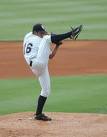
Youth Baseball Pitching - Rarely Seen Anymore
You learn from repetition and changing from the full wind up to the stretch denies that full time repetition. I also found my players had better and more consistent control when throwing from the stretch. They seemed to concentrate more on their grip than their windup.
As I remarked earlier, this is not a rock solid “must do“. I know coaches who feel the simultaneous learning of both wind ups are very important and can present an impressive argument for their method.
Not saying "I'm 100% right. I'm saying a good coach will evaluate his players, the arguments pro and con, then make the decision he believes is best for his players.
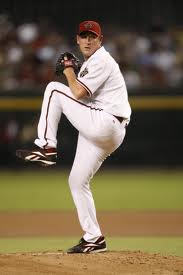
Youth Baseball Pitching - Balanced
Let’s begin our process of teaching our young athletes Fluid mechanics. You notice I bolded fluid. Their motion must never be mechanical or jerky, but a smooth fluid motion, with every motion having a purpose.
Pitching, just as every other position in baseball, requires a mental discipline, which accompanies the physical discipline. A coach must realize he’s working with a blank page, with no established habits or attitudes, which can be intimidating to an inexperienced coach.
One of these habits, which will be developed at a young age, is the speed in which the pitcher works. Notice how some major league pitchers work very quickly, while others nearly lull you to sleep between pitches? This is a pattern most likely developed at a young age.
Speed aside, which most times will be a reflection of the pitcher’s personality, Pitchers need to develop a routine between pitches which he does every time. It doe not matter what the routine, picking up a hand full of dust, taking a deep breath, wiping his brow with his sleeve, as long as the routine is consistent, as this routine automatically focuses the mental and physical aspects of preparing to throw the next pitch.

That’s why you’ll see a batter continually stepping out of the batters box between pitches when he’s facing a pitcher who works quickly. It’s to disrupt his mental and physical focus by making him uncomfortable by forcing him to slow down
The Set-up or Stare:
The pitcher needs to come set, focus and visualize where he’s going to throw his pitch, as this imagery sets his muscle memory into action, and narrows the mind’s focus.
He should grip the ball in the glove the exact same way every time, holding not squeezing the ball with the front two fingers. *** The older players become and the more types of pitches they throw, the pitcher should always start with the grip Most Difficult for him to achieve. ****

Youth Baseball Pitching - Freezing Runners
He should stare at the catcher’s mitt, visualizing a quarter in the mitt’s pocket, that’s his target not the entire mitt, and as he progresses he’ll focus on an imaginary quarter, then reduce it to an imaginary dime. This maximizes focus.
Coming to Stretch Position:
While standing, legs @ 3 feet apart, the pitcher places the side of his rear foot ( right foot if a righty …left foot if a lefty ) against the pitcher’s rubber. I’ll repeat Against, not on top of the rubber.
Some may want to bend over slightly, others stand more erect, doesn’t matter, whatever is comfortable for you.
As you stand against the rubber, breathing, don’t forget to breathe, begin your narrowing of focus as you take the catcher’s signals, again breathe and move the lead leg back towards your back leg and become set.
The distance between the legs at the set position is dependent on what’s comfortable and natural for the pitcher. The lead leg does not have to be in an exaggerated bent position, but never locked straight.
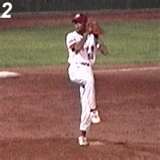
Youth Baseball Pitching - Good Balance
Simultaneously, as you are bringing your lead leg backwards to your rear leg, you should also be bringing your hands together, chest high a couple of inches away from the chest.
Pause and locate the quarter inside the catcher’s mitt. Lift your front leg upward with the knee stopping about chest high. *** Balance is critical at this stage and a good drill is to have the pitchers practice holding this position for at least 5 seconds or longer at a time. This will accustom the body to the position and make balancing second nature.
As the lead leg goes forward and downward the hands begin to come apart. The left arm will open and point homeward, the right arm will extend backwards toward second base.

Youth Baseball Pitching - Landing Straight
As the lead foot lands on the ground the shoulder and pitching arm should be coming up in a L at @ a right angle to the head. This is when the hips will explode through the zone, twisting and uncoiling like a spring, releasing maximum power for speed and velocity of the pitch.
The Landing:
The lead leg should stride out and extend as far as possible while still remaining comfortable. It should land on an imaginary line that extends from the rear foot to home plate.
If the foot lands too far on the right side of this line, the shoulders won’t be able to fully open and the pitcher will be forced to throw across his body, reducing velocity and putting undue stress on the shoulder.
If the foot lands too far to the left of the line, the shoulders will open too soon which will reduce velocity and control.
A Pitching basic drill to learn proper landing is to have the pitcher take his normal stand next to the pitching rubber. Draw a line in the dirt or chalk a line if on pavement from the rear foot to the plate. Have the pitcher practice his pitching motion paying special attention to where his foot lands in relation to the line.
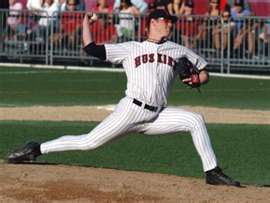
Youth Baseball Pitching - Good Form
** The landing line is not drawn from the middle of the pitching rubber to the plate unless the pitcher normally sets up in the middle of the rubber. The line begins from the exact point from which the pitcher stands against the rubber to pitch from.**
The Back or Rear Foot:
Here’s something that might blow your mind. The pitcher does not push off the rubber toward the plate, but rather uses the rear leg for balance as the hips move forward, turn and explode through the release zone.
The power and velocity comes from the hips in conjunction with arm speed, not the rear leg pushing forward. ( the legs are extremely important in the pitching and endurance process, but not for this reason. )
All pushing off the rubber will do is throw the pitcher off balance wrecking his entire delivery and creating chaos with his control. So next time you hear an opposing coach yelling at his pitcher “to push off and follow through” just smile to yourself.
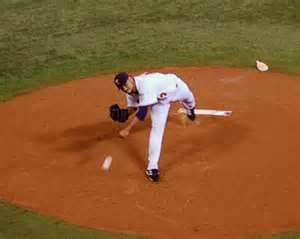
Youth Baseball Pitching - Follow Through
The rotation of the hips is what brings the rear foot forward, lifting it up off the ground. Should you see your pitcher dragging his rear foot …he is losing power, either from poor mechanics or fatigue.
Release and Follow Through.
The ball should be released out in front of the head…. The wrist should snap forward as the ball is released from the hand…. The throwing arm should continue across the body ending around the pitcher’s plant knee.
It’s important to finish the follow through as the energy exerted flows through and out the arm instead of slamming the brakes on coiled muscles, a good way to incur injuries.
Youth Baseball Pitching Back To Learn to Pitch

New! Comments
Have your say about what you just read! Leave me a comment in the box below.